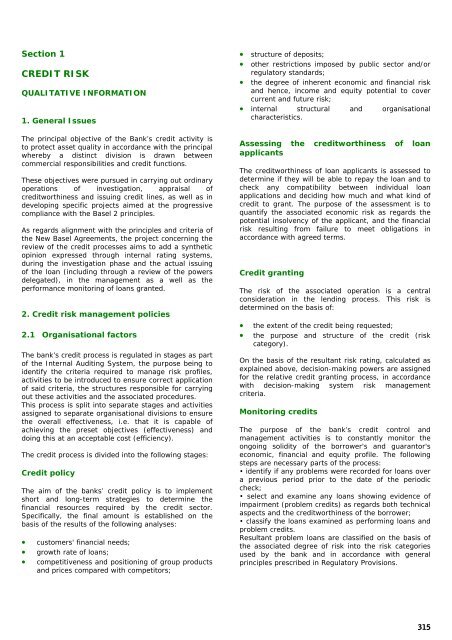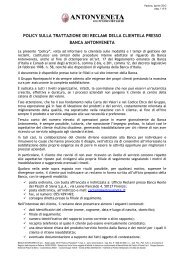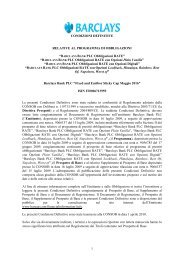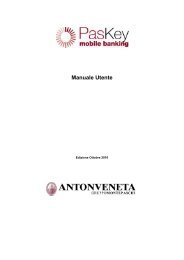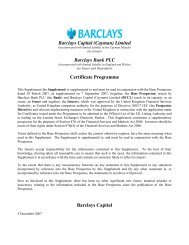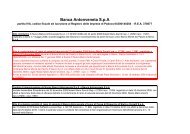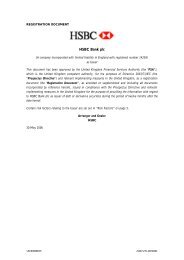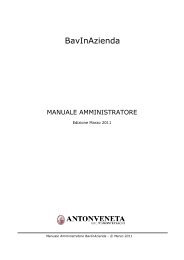- Page 1:
\\ItAntonvenetaAnnualReport2007XII
- Page 6:
Board of DirectorsChairman * France
- Page 12:
GROUPSTRUCTUREANTONVENETAANTONVENET
- Page 18 and 19:
The Macroeconomic ScenarioDear Shar
- Page 20 and 21:
• Santander: Business unit in Lat
- Page 22 and 23:
Performance in 2007Comparability wi
- Page 24 and 25:
As at 31 December 2007, loans to cu
- Page 26 and 27:
In detail, 19 new issues of unit-li
- Page 28 and 29:
The economic and financial performa
- Page 30 and 31:
Impaired and performingloansNET POS
- Page 32 and 33:
Income StatementThe 2007 income sta
- Page 34 and 35:
Performance of the main Antonveneta
- Page 36 and 37:
Antenore Finance Società dicartola
- Page 38:
Relevant events occurred after clos
- Page 51 and 52:
CONSOLIDATED FINANCIAL STATEMENTSCo
- Page 53 and 54:
Consolidated Income Statement€/th
- Page 55 and 56:
Statement of changes in consolidate
- Page 62 and 63:
A.1 - GENERAL PARTSection 1 - PREPA
- Page 64:
investments are originally recognis
- Page 67 and 68:
loans past due for over 180 days ac
- Page 69 and 70:
Valuation criteria and recognition
- Page 71 and 72:
Financial liabilities held for trad
- Page 73 and 74:
Prepaid tax assets and deferred tax
- Page 78 and 79:
ASSETSSection 1Cash and cash equiva
- Page 80 and 81:
2.2 Financial assets held for tradi
- Page 82 and 83:
Section 3Financial assets designate
- Page 84 and 85:
Section 4Financial assets available
- Page 86 and 87:
4.5.1 Financial assets available fo
- Page 88 and 89:
Section 7Loans to customers - Entry
- Page 90 and 91:
Section 8Hedging derivative contrac
- Page 92 and 93:
Section 12Tangible fixed assets - E
- Page 94 and 95:
12.3.3 Fixed assets for functional
- Page 96 and 97:
Section 14Tax assets and liabilitie
- Page 98 and 99:
14.5 Changes in prepaid taxes (offs
- Page 100 and 101:
Section 16Other assets - Entry 1601
- Page 102 and 103:
Section 2Due to customers - Entry 2
- Page 104 and 105:
3.3 Securities issued: securities u
- Page 106 and 107:
4.4.1 Trading financial liabilities
- Page 108 and 109:
Section 8Tax liabilities - Entry 80
- Page 110 and 111:
The actuarial assumptions used in t
- Page 112 and 113:
• discount rate. The financial ba
- Page 114 and 115:
12.3.2 Personnel pension fund (ex-B
- Page 116 and 117:
15.5 Income reserves: other informa
- Page 118 and 119:
Section 16Minority interests - Entr
- Page 120 and 121:
OTHER INFORMATION1. Guarantees and
- Page 122 and 123:
121
- Page 124 and 125:
Section 1Interest - Entries 10 and
- Page 126 and 127:
Section 2Commissions - Entries 40 a
- Page 128 and 129:
Section 3Dividends and similar inco
- Page 130 and 131:
Section 5Net profit on hedging - En
- Page 132 and 133:
Section 7Net change in value of fin
- Page 134 and 135:
Section 11Administrative expenses -
- Page 136 and 137:
Section 12Net allowances for risks
- Page 138 and 139:
Section 14Net value adjustments to
- Page 140 and 141:
Section 16Profits (Losses) from inv
- Page 142 and 143:
Section 20Taxes on income from cont
- Page 144 and 145:
Section 22Third party profit (loss)
- Page 146 and 147:
145
- Page 148 and 149:
A. PRIMARY REPORTINGA.1. Distributi
- Page 150 and 151:
This section provides information w
- Page 152 and 153:
Section 1CREDIT RISKQUANTITATIVE IN
- Page 154 and 155:
A.1.5 Cash Exposures to Banks: Tren
- Page 156 and 157:
A.3 DISTRIBUTION OF GUARANTEED EXPO
- Page 158 and 159:
A.3.4 Impaired "off balance sheet"
- Page 160 and 161:
B.1 By-sector distribution of cash
- Page 162 and 163:
C. SECURITISATIONS AND TRANSFER OF
- Page 164 and 165:
THEANO FINANCE SPASUMMARY STATEMENT
- Page 166 and 167:
GIOTTO FINANCE 2 SPASUMMARY STATEME
- Page 168 and 169:
2.3 PRICE RISKREGULATORY TRADING PO
- Page 170 and 171:
2.5 EXCHANGE RATE RISKQUANTITATIVE
- Page 172 and 173:
2.6 DERIVATIVE FINANCIAL INSTRUMENT
- Page 174 and 175:
A.2 Bank Portfolio: notional values
- Page 176 and 177:
A.4 "Over the counter" financial de
- Page 178 and 179:
A.6 Residual duration of "over the
- Page 180 and 181:
Currency: STERLINGEntry/Time bandOn
- Page 182 and 183:
2. Distribution of financial liabil
- Page 184 and 185:
183
- Page 186 and 187:
Section 1Shareholders' equityA. QUA
- Page 188 and 189:
B. QUANTITATIVE INFORMATIONExposure
- Page 190 and 191:
189
- Page 192 and 193:
1 - Information on directors' and e
- Page 194 and 195:
193
- Page 196 and 197:
INDIVIDUAL FINANCIAL STATEMENTS DAT
- Page 198 and 199:
197
- Page 200 and 201:
Dear Shareholders,In addition to il
- Page 202 and 203:
Banca Antonveneta in 2007, a new se
- Page 204 and 205:
Distribution ChannelsDuring 2007, B
- Page 206 and 207:
The Economic and Financial TrendsDe
- Page 208 and 209:
INDIRECT DEPOSITS(in millions of Eu
- Page 210 and 211:
Financial Assets(€/thousand)31.12
- Page 212 and 213:
Income StatementThe Income Statemen
- Page 214 and 215:
Relevant events occurred after the
- Page 216 and 217:
215
- Page 218 and 219:
217
- Page 220 and 221:
219
- Page 222 and 223:
4. During the fiscal year 2007, the
- Page 224 and 225:
223
- Page 226 and 227:
225
- Page 228 and 229:
Balance Sheet - Liabilities and sha
- Page 230 and 231:
Statement of changes in consolidate
- Page 232 and 233:
CASH FLOW STATEMENT (Direct method)
- Page 234 and 235:
233
- Page 236 and 237:
235
- Page 238 and 239:
A.1 - GENERALSection 1 - Statement
- Page 240 and 241:
the accumulated profit or loss are
- Page 242 and 243:
Recognition and derecognition crite
- Page 244 and 245:
Intangible fixed assets include goo
- Page 246 and 247:
Valuation criteria and recognition
- Page 248 and 249:
247
- Page 250 and 251:
ASSETSSection 1Cash and cash equiva
- Page 252 and 253:
2.2 Financial assets held for tradi
- Page 254 and 255:
Section 3Financial assets designate
- Page 256 and 257:
Section 4Financial assets available
- Page 258 and 259:
4.5 Financial assets available for
- Page 260 and 261:
Section 7Loans to customers - Entry
- Page 262 and 263:
Section 8Hedging derivative contrac
- Page 264 and 265:
10.3 Investments: annual changes31.
- Page 266 and 267: 11.3 Fixed assets for functional us
- Page 268 and 269: Section 12Intangible fixed assets -
- Page 270 and 271: 13.2 Deferred tax liabilities: brea
- Page 272 and 273: 13.5 Changes in prepaid taxes (offs
- Page 274 and 275: Section 15Other assets - Entry 1501
- Page 276 and 277: Section 2Due to customers - Entry 2
- Page 278 and 279: 3.3 Securities issued: securities u
- Page 280 and 281: 4.4 Trading financial liabilities:
- Page 282 and 283: Section 8Tax liabilities - Entry 80
- Page 284 and 285: The actuarial assumptions used in t
- Page 286 and 287: • discount rate. The financial ba
- Page 288 and 289: 12.3.2 Personnel pension fund (ex-B
- Page 290 and 291: 14.5 Income reserves: other informa
- Page 292 and 293: Other information1. Guarantees and
- Page 294 and 295: 293
- Page 296 and 297: Section 1Interest - Entries 10 and
- Page 298 and 299: Section 2Commissions - Entries 40 a
- Page 300 and 301: Section 3Dividends and similar inco
- Page 302 and 303: Section 5Net profit on hedging - En
- Page 304 and 305: Section 7Net profit/(loss) from fin
- Page 306 and 307: Section 9Administrative expenses -
- Page 308 and 309: Section 10Net allowances for risks
- Page 310 and 311: Section 14Profits (Losses) from inv
- Page 312 and 313: Section 19Income (loss) after tax f
- Page 314 and 315: 313
- Page 318 and 319: As a final measure, specific regula
- Page 320 and 321: In this type of control, typical cr
- Page 322 and 323: A.1.3 Exposure to Cash and Off-Bala
- Page 324 and 325: A.2 CLASSIFICATION OF EXPOSURES BY
- Page 326 and 327: A.3.3 Impaired cash exposures towar
- Page 328 and 329: B. DISTRIBUTION AND CONCENTRATION O
- Page 330 and 331: C. SECURITISATIONS AND TRANSFER OF
- Page 332 and 333: C.1.2 Exposures deriving from princ
- Page 334 and 335: C.1.7 Service activities - revenue
- Page 336 and 337: Section 2MARKET RISK2.1 INTEREST RA
- Page 338 and 339: Risk controlRisk control is carried
- Page 340 and 341: 2.2 INTEREST RATE RISKBANK PORTFOLI
- Page 342 and 343: QUANTITATIVE INFORMATIONSensitivity
- Page 344 and 345: 2. Regulatory trading portfolio: di
- Page 346 and 347: transactions, (iii) comparable tran
- Page 348 and 349: 2.5 EXCHANGE RATE RISKQUALITATIVE I
- Page 350 and 351: 2.6 DERIVATIVE FINANCIAL INSTRUMENT
- Page 352 and 353: A.3 Derivatives: Purchase and Sale
- Page 354 and 355: A.5 "Over the counter" financial de
- Page 356 and 357: SECTION 3LIQUIDITY RISKQUALITATIVE
- Page 358 and 359: Currency: SterlingEntry/Time bandOn
- Page 360 and 361: 2. Distribution of financial liabil
- Page 362 and 363: • attributing the regular segment
- Page 364 and 365: 363
- Page 366 and 367:
Section 1Company assetsA. QUALITATI
- Page 368 and 369:
B. QUANTITATIVE INFORMATIONExposure
- Page 370 and 371:
Breakdown of net shareholders' equi
- Page 372 and 373:
371
- Page 374 and 375:
Fees to directors, board of auditor
- Page 376 and 377:
Information required by art. 2497 b
- Page 378 and 379:
377
- Page 380 and 381:
EQUITY INVESTMENTS Situation at 31
- Page 382 and 383:
INTERNATIONAL ACCOUNTING STANDARDS
- Page 384 and 385:
383
- Page 386 and 387:
385
- Page 388:
387


